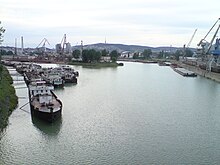Port of Bratislava
| Port of Bratislava Prístav Bratislava |
|
|---|---|

Winter harbor of the Bratislava cargo port
|
|
| Location | |
| Country | Slovakia |
| Location | Bratislava, Horárska Street No. 12 |
| Coordinates | 48° 7' 50" N 17° 8' 42" E |
| Details | |
| Type of harbor | River port |
| Size | Medium |
|
Website www.vpas.sk/en/ |
|
The Port of Bratislava (Slovak: Prístav Bratislava) is a major port on the river Danube and — in a wider sense — on the Rhine-Main-Danube waterway, located in Bratislava, the capital of Slovakia. It is a universal inland port consisting of two parts, a cargo port and a passenger port. The former is a key facility for Slovakia's economy as the largest of three international ports in Slovakia, the others being in Komárno and Štúrovo. The port lies at the strategic intersection of the Rhine-Main-Danube Canal with the Baltic-Adriatic Corridor, part of the Trans-European Transport Networks, and it is conveniently located near two major ports: Port of Vienna and Port of Budapest.
The port authority for the Port of Bratislava is the company Verejné prístavy, a.s. (Public ports, jsc.) (VP). The port is connected to railway, highway and a pipeline transport system to the Slovnaft refinery. Land underneath the cargo port is owned by the state company Verejné prístavy, a.s., all buildings and objects are owned by Slovenská Plavba a Prístavy, a.s.. The cargo port lies at the left riverbank of the Danube, from river kilometer 1 867,290 until 1862,000. Both adjacent riverbanks belong to the Port of Bratislava.
In the last decade of the 19th century the Danube riverbank adjacent to the city center of Bratislava (called Pressburg or Pozsony at that time) underwent major changes. In 1890, a new steel bridge called Franz Joseph Brücke (today the Old bridge of Bratislava) was opened and shortly afterwards the construction of the nearby port began. The area along the riverbank from today's Slovak National Museum headquarters until the today's Apollo bridge was converted to accommodate the mooring of up to 250 cargo ships. These activities were driven mainly by the commercial interests of transport companies on the Danube and the state of Austria-Hungary financially participated only minimally.
...
Wikipedia
